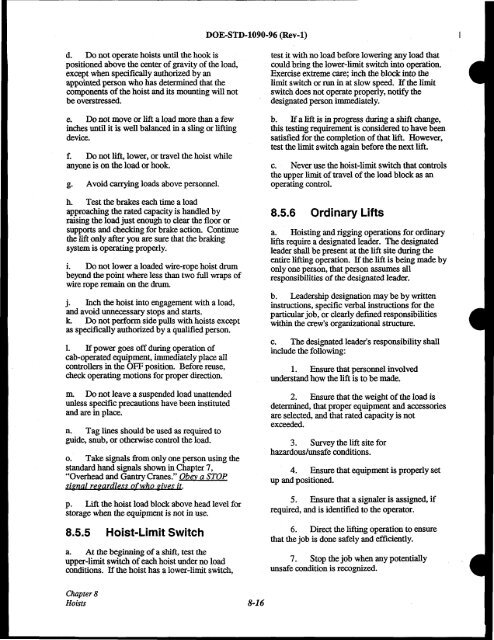DOE-STD-1090-96, DOE Standard Hoisting and Rigging Manual ...
DOE-STD-1090-96, DOE Standard Hoisting and Rigging Manual ...
DOE-STD-1090-96, DOE Standard Hoisting and Rigging Manual ...
Create successful ePaper yourself
Turn your PDF publications into a flip-book with our unique Google optimized e-Paper software.
<strong>DOE</strong>-<strong>STD</strong>-I090-<strong>96</strong> (Rev-I)d. Do not operate hoists until the hook ispositioned above the center ofgravity ofthe load,except when specifically authorized by anappointed person who has determined that thecomponents ofthe hoist <strong>and</strong> its mounting will notbe overstressed.e. Do not move or lift a load more than a fewinches until it is well balanced in a sling or liftingdevice.f. Do not lift, lower, or travel the hoist whileanyone is on the load or hook.g. Avoid carrying loads above personnel.h. Test the brakes each time a loadapproaching the rated capacity is h<strong>and</strong>led byraising the loadjust enough to clear the floor orsupports <strong>and</strong> checking for brake action. Continuethe lift only after you are sure that the brakingsystem is operating properly.i. Do not lower a loaded wire-rope hoist drumbeyond the point where less than two full wraps ofwire rope remain on the drum.j. Inch the hoist into engagement with a load,<strong>and</strong> avoid unnecessary stops <strong>and</strong> starts.k. Do not perfonn side pulls with hoists exceptas specifically authorized by a qualified person.1. Ifpower goes off during operation ofcab-operated equipment, immediately place allcontrollers in the OFF position. Before reuse,check operating motions for proper direction.m. Do not leave a suspended load unattendedunless specific precautions have been instituted<strong>and</strong> are in place.n. Tag lines should be used as required toguide, snub, or otherwise control the load.o. Take signals from only one person using thest<strong>and</strong>ard h<strong>and</strong> signals shown in Chapter 7,"Overhead <strong>and</strong> Gantry Cranes." Obey a STOPsignal regardless ofwho gives it.p. Lift the hoist load block above head level forstorage when the equipment is not in use.8.5.5Hoist-Limit Switcha. At the beginning ofa shift, test theupper-limit switch ofeach hoist under no loadconditions. Ifthe hoist has a lower-limit switch,test it with no load before lowering any load thatcould bring the lower-limit switch into operation.Exercise extreme care; inch the block into thelimit switch or run in at slow speed. Ifthe limitswitch does not operate properly, notify thedesignated person immediately.b. Ifa lift is in progress during a shift change,this testing requirement is considered to have beensatisfied for the completion ofthat lift. However,test the limit switch again before the next lift.c. Never use the hoist-limit switch that controlsthe upper limit oftravel of the load block as anoperating control.8.5.6Ordinary Liftsa. <strong>Hoisting</strong> <strong>and</strong> rigging operations for ordinarylifts require a designated leader. The designatedleader shall be present at the lift site during theentire lifting operation. Ifthe lift is being made byonly one person, that person assumes allresponsibilities ofthe designated leader.b. Leadership designation may be by writteninstructions, specific verbal instructions for theparticularjob, or clearly defmed responsibilitieswithin the crew's organizational structure.c. The designated leader's responsibility shallinclude the following:1. Ensure that personnel involvedunderst<strong>and</strong> how the lift is to be made.2. Ensure that the weight ofthe load isdetermined, that proper equipment <strong>and</strong> accessoriesare selected, <strong>and</strong> that rated capacity is notexceeded.3. Survey the lift site forhazardous/unsafe conditions.4. Ensure that equipment is properly setup <strong>and</strong> positioned.5. Ensure that a signaler is assigned, ifrequired, <strong>and</strong> is identified to the operator.6. Direct the lifting operation to ensurethat the job is done safely <strong>and</strong> efficiently.7. Stop thejob when any potentiallyunsafe condition is recognized.Chapter 8Hoists 8-16
















